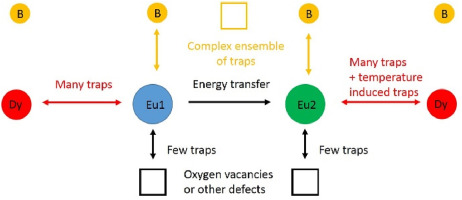Our official English website, www.x-mol.net, welcomes your feedback! (Note: you will need to create a separate account there.)
Probing traps in the persistent phosphor SrAl2O4:Eu2+,Dy3+,B3+ - A wavelength, temperature and sample dependent thermoluminescence investigation
Journal of Luminescence ( IF 3.6 ) Pub Date : 2020-06-01 , DOI: 10.1016/j.jlumin.2020.117113 Jakob Bierwagen , Teresa Delgado , Guillaume Jiranek , Songhak Yoon , Nando Gartmann , Bernhard Walfort , Markus Pollnau , Hans Hagemann
Journal of Luminescence ( IF 3.6 ) Pub Date : 2020-06-01 , DOI: 10.1016/j.jlumin.2020.117113 Jakob Bierwagen , Teresa Delgado , Guillaume Jiranek , Songhak Yoon , Nando Gartmann , Bernhard Walfort , Markus Pollnau , Hans Hagemann

|
Abstract Wavelength-dependent thermoluminescence (TL) experiments were performed on SrAl2O4:Eu, SrAl2O4:Eu,B, SrAl2O4:Eu,Dy and SrAl2O4:Eu,Dy,B polycrystalline samples. Excitation at 445 nm allows to selectively excite one of the two different Eu2+ ions substituting for Sr in the crystal, whereas excitation at 375 nm excites both Eu2+ ions. Incorporation of boron generates the deepest traps which contribute to the very long afterglow in this material, while dysprosium increases significantly (by a factor of about 4–8) the total number of traps involved in the afterglow of this persistent phosphor. Increasing the temperature at which the samples are irradiated (loaded) from 173 K to 248 K reveals that many new traps can only be occupied or activated at higher temperatures, leading to a strong increase of the integrated TL intensity, in particular for the Dy-containing samples. Boron does not appear to contribute to these thermally-activated traps significantly responsible for the long afterglow of SrAl2O4:Eu,Dy,B. The results of this study reveal that the diversity of traps leading to the long afterglow is much larger than previously reported in the literature. We propose that boron stabilizes F centers (which absorb in the far UV), while the presence of dysprosium induces an excitation-induced charge-transfer reaction Eu2+ + Dy3+ → Eu3+ + Dy2+. However, the principal traps responsible for the efficient afterglow are temperature-activated and appear to be associated with the green emitting Eu2+ ion on the Sr2 site coupled to a nearby dysprosium ion.
中文翻译:

持久性磷光体 SrAl2O4:Eu2+,Dy3+,B3+ 中的探测陷阱 - 波长、温度和样品相关的热释光研究
摘要 对 SrAl2O4:Eu、SrAl2O4:Eu,B、SrAl2O4:Eu,Dy 和 SrAl2O4:Eu,Dy,B 多晶样品进行了波长相关热释光 (TL) 实验。445 nm 激发允许选择性激发两种不同 Eu2+ 离子中的一种,替代晶体中的 Sr,而 375 nm 激发可激发两种 Eu2+ 离子。硼的掺入会产生最深的陷阱,这有助于这种材料中非常长的余辉,而镝显着增加(约 4-8 倍)参与这种持久磷光体余辉的陷阱总数。将样品辐照(装载)的温度从 173 K 增加到 248 K,表明许多新的陷阱只能在更高的温度下被占据或激活,从而导致积分 TL 强度的强烈增加,特别是对于含 Dy 的样品。硼似乎对这些热激活陷阱没有贡献,这对 SrAl2O4:Eu,Dy,B 的长余辉有重要影响。这项研究的结果表明,导致长余辉的陷阱的多样性比以前文献中报道的要多得多。我们建议硼稳定 F 中心(在远紫外线中吸收),而镝的存在诱导激发诱导的电荷转移反应 Eu2+ + Dy3+ → Eu3+ + Dy2+。然而,负责有效余辉的主要陷阱是温度激活的,并且似乎与 Sr2 位点上的绿色 Eu2+ 离子耦合到附近的镝离子相关。硼似乎对这些热激活陷阱没有贡献,这对 SrAl2O4:Eu,Dy,B 的长余辉有重要影响。这项研究的结果表明,导致长余辉的陷阱的多样性比以前文献中报道的要多得多。我们建议硼稳定 F 中心(在远紫外线中吸收),而镝的存在诱导激发诱导的电荷转移反应 Eu2+ + Dy3+ → Eu3+ + Dy2+。然而,负责有效余辉的主要陷阱是温度激活的,并且似乎与 Sr2 位点上的绿色 Eu2+ 离子耦合到附近的镝离子相关。硼似乎对这些热激活陷阱没有贡献,这对 SrAl2O4:Eu,Dy,B 的长余辉有重要影响。这项研究的结果表明,导致长余辉的陷阱的多样性比以前文献中报道的要多得多。我们建议硼稳定 F 中心(在远紫外线中吸收),而镝的存在诱导激发诱导的电荷转移反应 Eu2+ + Dy3+ → Eu3+ + Dy2+。然而,负责有效余辉的主要陷阱是温度激活的,并且似乎与 Sr2 位点上的绿色 Eu2+ 离子耦合到附近的镝离子相关。这项研究的结果表明,导致长余辉的陷阱的多样性比以前文献中报道的要多得多。我们建议硼稳定 F 中心(在远紫外线中吸收),而镝的存在诱导激发诱导的电荷转移反应 Eu2+ + Dy3+ → Eu3+ + Dy2+。然而,负责有效余辉的主要陷阱是温度激活的,并且似乎与 Sr2 位点上的绿色 Eu2+ 离子耦合到附近的镝离子相关。这项研究的结果表明,导致长余辉的陷阱的多样性比以前文献中报道的要多得多。我们建议硼稳定 F 中心(在远紫外线中吸收),而镝的存在诱导激发诱导的电荷转移反应 Eu2+ + Dy3+ → Eu3+ + Dy2+。然而,负责有效余辉的主要陷阱是温度激活的,并且似乎与 Sr2 位点上的绿色 Eu2+ 离子耦合到附近的镝离子相关。
更新日期:2020-06-01
中文翻译:

持久性磷光体 SrAl2O4:Eu2+,Dy3+,B3+ 中的探测陷阱 - 波长、温度和样品相关的热释光研究
摘要 对 SrAl2O4:Eu、SrAl2O4:Eu,B、SrAl2O4:Eu,Dy 和 SrAl2O4:Eu,Dy,B 多晶样品进行了波长相关热释光 (TL) 实验。445 nm 激发允许选择性激发两种不同 Eu2+ 离子中的一种,替代晶体中的 Sr,而 375 nm 激发可激发两种 Eu2+ 离子。硼的掺入会产生最深的陷阱,这有助于这种材料中非常长的余辉,而镝显着增加(约 4-8 倍)参与这种持久磷光体余辉的陷阱总数。将样品辐照(装载)的温度从 173 K 增加到 248 K,表明许多新的陷阱只能在更高的温度下被占据或激活,从而导致积分 TL 强度的强烈增加,特别是对于含 Dy 的样品。硼似乎对这些热激活陷阱没有贡献,这对 SrAl2O4:Eu,Dy,B 的长余辉有重要影响。这项研究的结果表明,导致长余辉的陷阱的多样性比以前文献中报道的要多得多。我们建议硼稳定 F 中心(在远紫外线中吸收),而镝的存在诱导激发诱导的电荷转移反应 Eu2+ + Dy3+ → Eu3+ + Dy2+。然而,负责有效余辉的主要陷阱是温度激活的,并且似乎与 Sr2 位点上的绿色 Eu2+ 离子耦合到附近的镝离子相关。硼似乎对这些热激活陷阱没有贡献,这对 SrAl2O4:Eu,Dy,B 的长余辉有重要影响。这项研究的结果表明,导致长余辉的陷阱的多样性比以前文献中报道的要多得多。我们建议硼稳定 F 中心(在远紫外线中吸收),而镝的存在诱导激发诱导的电荷转移反应 Eu2+ + Dy3+ → Eu3+ + Dy2+。然而,负责有效余辉的主要陷阱是温度激活的,并且似乎与 Sr2 位点上的绿色 Eu2+ 离子耦合到附近的镝离子相关。硼似乎对这些热激活陷阱没有贡献,这对 SrAl2O4:Eu,Dy,B 的长余辉有重要影响。这项研究的结果表明,导致长余辉的陷阱的多样性比以前文献中报道的要多得多。我们建议硼稳定 F 中心(在远紫外线中吸收),而镝的存在诱导激发诱导的电荷转移反应 Eu2+ + Dy3+ → Eu3+ + Dy2+。然而,负责有效余辉的主要陷阱是温度激活的,并且似乎与 Sr2 位点上的绿色 Eu2+ 离子耦合到附近的镝离子相关。这项研究的结果表明,导致长余辉的陷阱的多样性比以前文献中报道的要多得多。我们建议硼稳定 F 中心(在远紫外线中吸收),而镝的存在诱导激发诱导的电荷转移反应 Eu2+ + Dy3+ → Eu3+ + Dy2+。然而,负责有效余辉的主要陷阱是温度激活的,并且似乎与 Sr2 位点上的绿色 Eu2+ 离子耦合到附近的镝离子相关。这项研究的结果表明,导致长余辉的陷阱的多样性比以前文献中报道的要多得多。我们建议硼稳定 F 中心(在远紫外线中吸收),而镝的存在诱导激发诱导的电荷转移反应 Eu2+ + Dy3+ → Eu3+ + Dy2+。然而,负责有效余辉的主要陷阱是温度激活的,并且似乎与 Sr2 位点上的绿色 Eu2+ 离子耦合到附近的镝离子相关。


























 京公网安备 11010802027423号
京公网安备 11010802027423号